belt MAZDA MODEL MX-5 MIATA PRHT 2012 Owner's Manual
[x] Cancel search | Manufacturer: MAZDA, Model Year: 2012, Model line: MODEL MX-5 MIATA PRHT, Model: MAZDA MODEL MX-5 MIATA PRHT 2012Pages: 456, PDF Size: 5.68 MB
Page 34 of 456
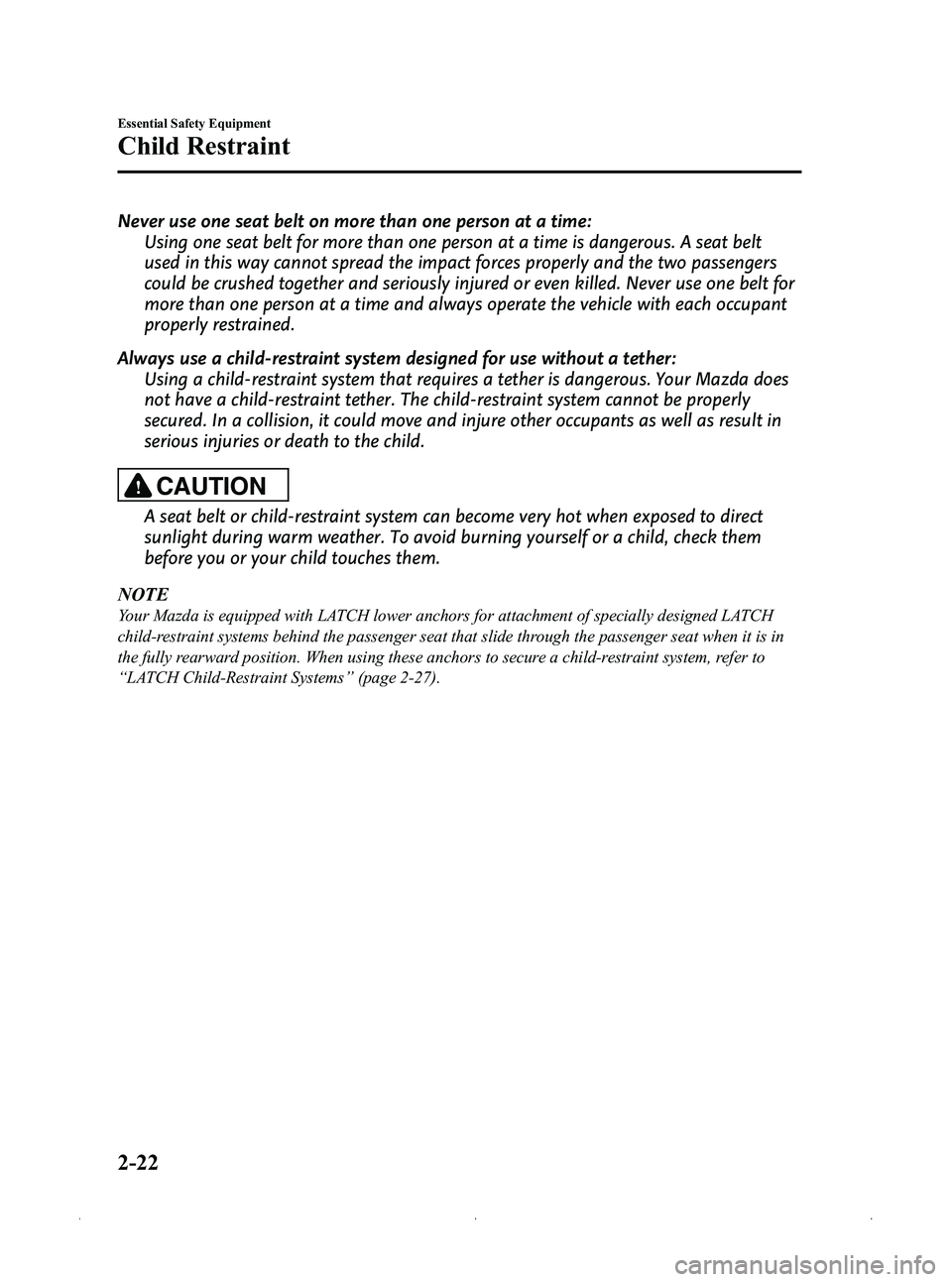
Black plate (34,1)
Never use one seat belt on more than one person at a time:Using one seat belt for more than one person at a time is dangerous. A seat belt
used in this way cannot spread the impact forces properly and the two passengers
could be crushed together and seriously injured or even killed. Never use one belt for
more than one person at a time and always operate the vehicle with each occupant
properly restrained.
Always use a child-restraint system designed for use without a tether: Using a child-restraint system that requires a tether is dangerous. Your Mazda does
not have a child-restraint tether. The child-restraint system cannot be properly
secured. In a collision, it could move and injure other occupants as well as result in
serious injuries or death to the child.
CAUTION
A seat belt or child-restraint system can become very hot when exposed to direct
sunlight during warm weather. To avoid burning yourself or a child, check them
before you or your child touches them.
NOTE
Your Mazda is equipped with LATCH lower anchors for attachment of specially designed LATCH
child-restraint systems behind the passenger seat that slide through the passenger seat when it is in
the fully rearward position. When using these anchors to secure a child-restraint system, refer to
“ LATCH Child-Restraint Systems ”(page 2-27).
2-22
Essential Safety Equipment
Child Restraint
MX-5_8CC1-EA-11F_Edition2 Page34
Monday, July 18 2011 10:7 AM
Form No.8CC1-EA-11F
Page 35 of 456
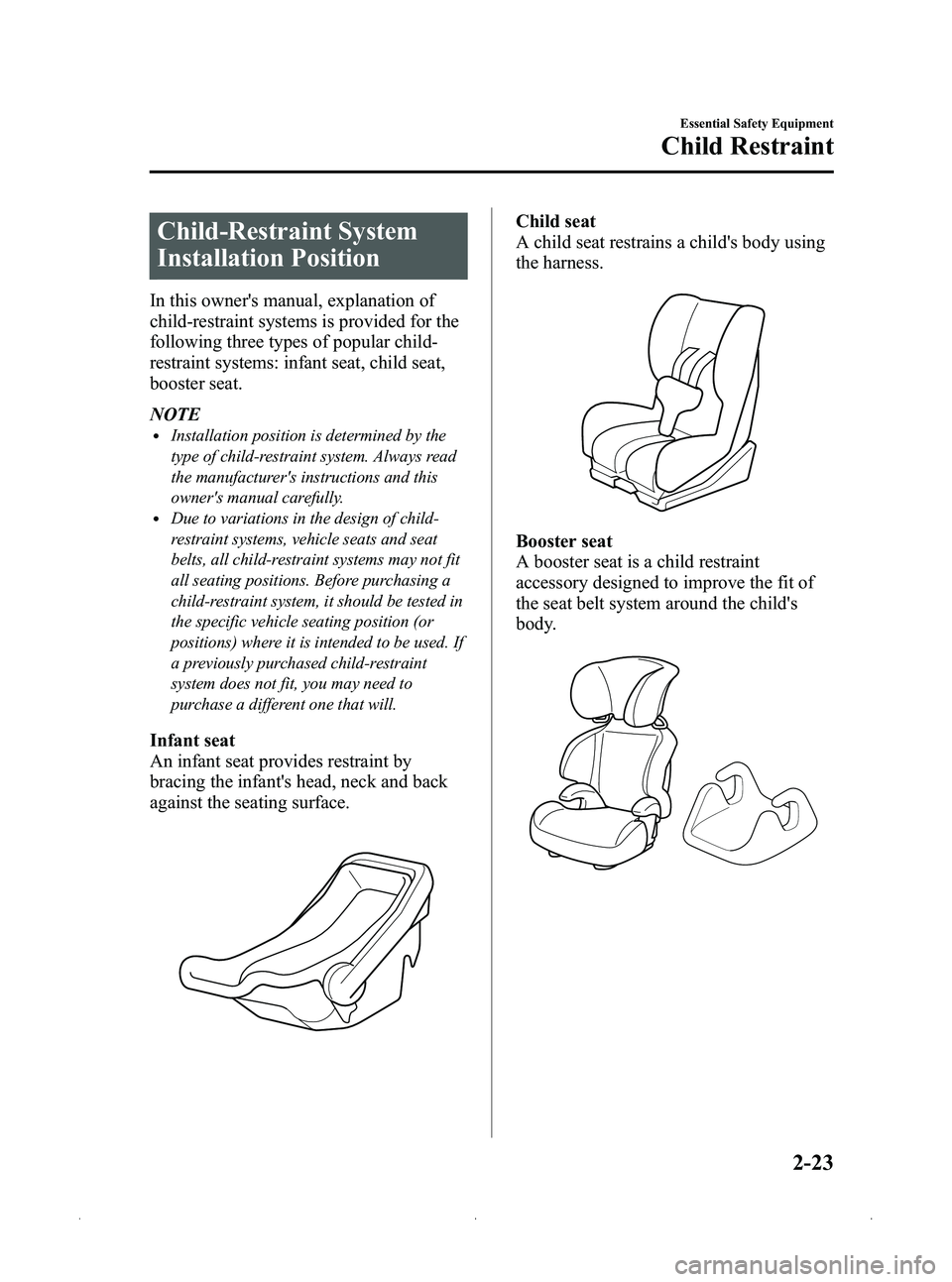
Black plate (35,1)
Child-Restraint System
Installation Position
In this owner's manual, explanation of
child-restraint systems is provided for the
following three types of popular child-
restraint systems: infant seat, child seat,
booster seat.
NOTE
lInstallation position is determined by the
type of child-restraint system. Always read
the manufacturer's instructions and this
owner's manual carefully.
lDue to variations in the design of child-
restraint systems, vehicle seats and seat
belts, all child-restraint systems may not fit
all seating positions. Before purchasing a
child-restraint system, it should be tested in
the specific vehicle seating position (or
positions) where it is intended to be used. If
a previously purchased child-restraint
system does not fit, you may need to
purchase a different one that will.
Infant seat
An infant seat provides restraint by
bracing the infant's head, neck and back
against the seating surface.
Child seat
A child seat restrains a child's body using
the harness.
Booster seat
A booster seat is a child restraint
accessory designed to improve the fit of
the seat belt system around the child's
body.
Essential Safety Equipment
Child Restraint
2-23
MX-5_8CC1-EA-11F_Edition2 Page35
Monday, July 18 2011 10:7 AM
Form No.8CC1-EA-11F
Page 36 of 456
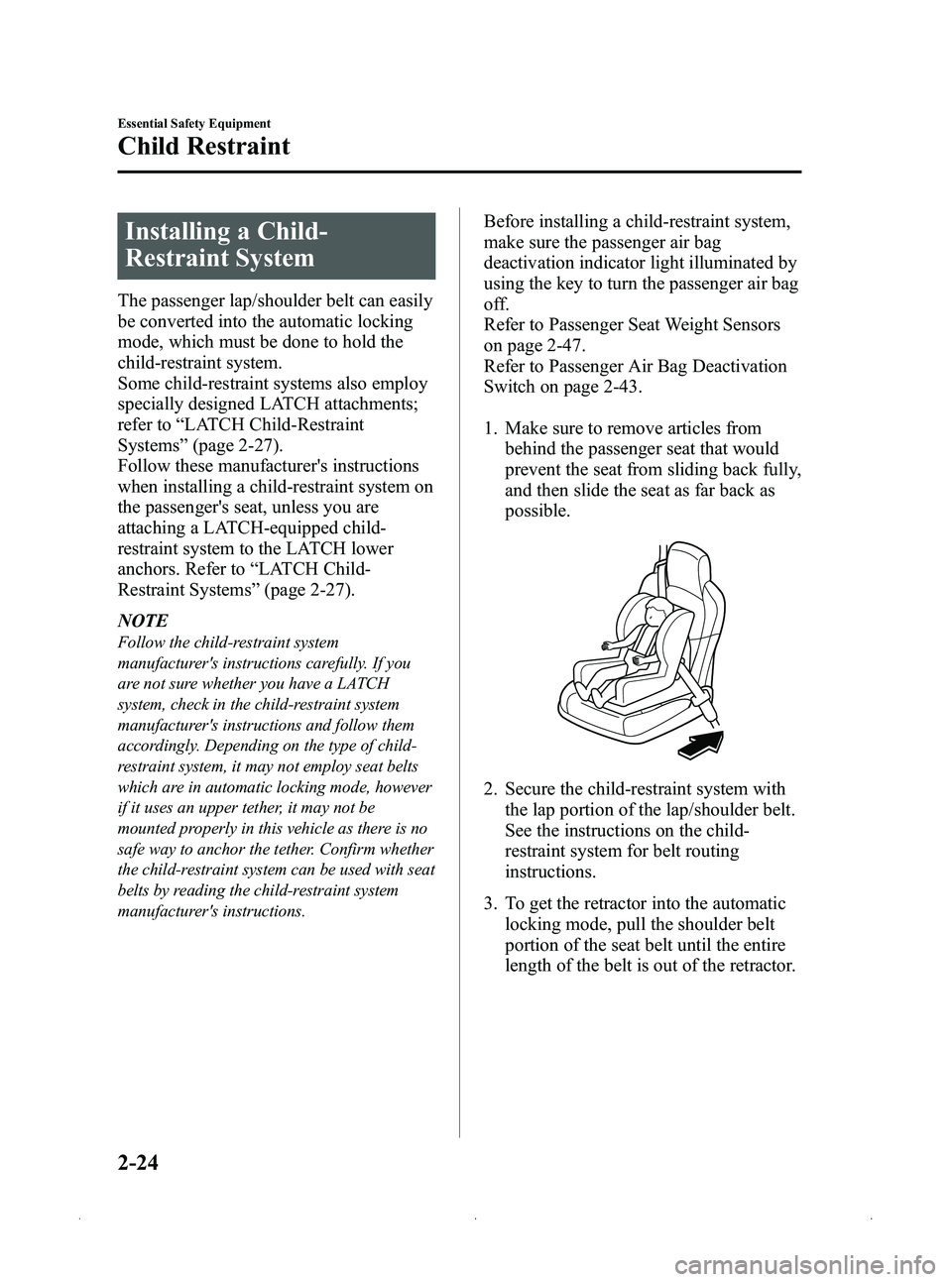
Black plate (36,1)
Installing a Child-
Restraint System
The passenger lap/shoulder belt can easily
be converted into the automatic locking
mode, which must be done to hold the
child-restraint system.
Some child-restraint systems also employ
specially designed LATCH attachments;
refer to“LATCH Child-Restraint
Systems ”(page 2-27).
Follow these manufacturer's instructions
when installing a child-restraint system on
the passenger's seat, unless you are
attaching a LATCH-equipped child-
restraint system to the LATCH lower
anchors. Refer to “LATCH Child-
Restraint Systems ”(page 2-27).
NOTE
Follow the child-restraint system
manufacturer's instructions carefully. If you
are not sure whether you have a LATCH
system, check in the child-restraint system
manufacturer's instructions and follow them
accordingly. Depending on the type of child-
restraint system, it may not employ seat belts
which are in automatic locking mode, however
if it uses an upper tether, it may not be
mounted properly in this vehicle as there is no
safe way to anchor the tether. Confirm whether
the child-restraint system can be used with seat
belts by reading the child-restraint system
manufacturer's instructions.
Before installing a child-restraint system,
make sure the passenger air bag
deactivation indicator light illuminated by
using the key to turn the passenger air bag
off.
Refer to Passenger Seat Weight Sensors
on page 2-47.
Refer to Passenger Air Bag Deactivation
Switch on page 2-43.
1. Make sure to remove articles from behind the passenger seat that would
prevent the seat from sliding back fully,
and then slide the seat as far back as
possible.
2. Secure the child-restraint system with
the lap portion of the lap/shoulder belt.
See the instructions on the child-
restraint system for belt routing
instructions.
3. To get the retractor into the automatic locking mode, pull the shoulder belt
portion of the seat belt until the entire
length of the belt is out of the retractor.
2-24
Essential Safety Equipment
Child Restraint
MX-5_8CC1-EA-11F_Edition2 Page36
Monday, July 18 2011 10:7 AM
Form No.8CC1-EA-11F
Page 37 of 456
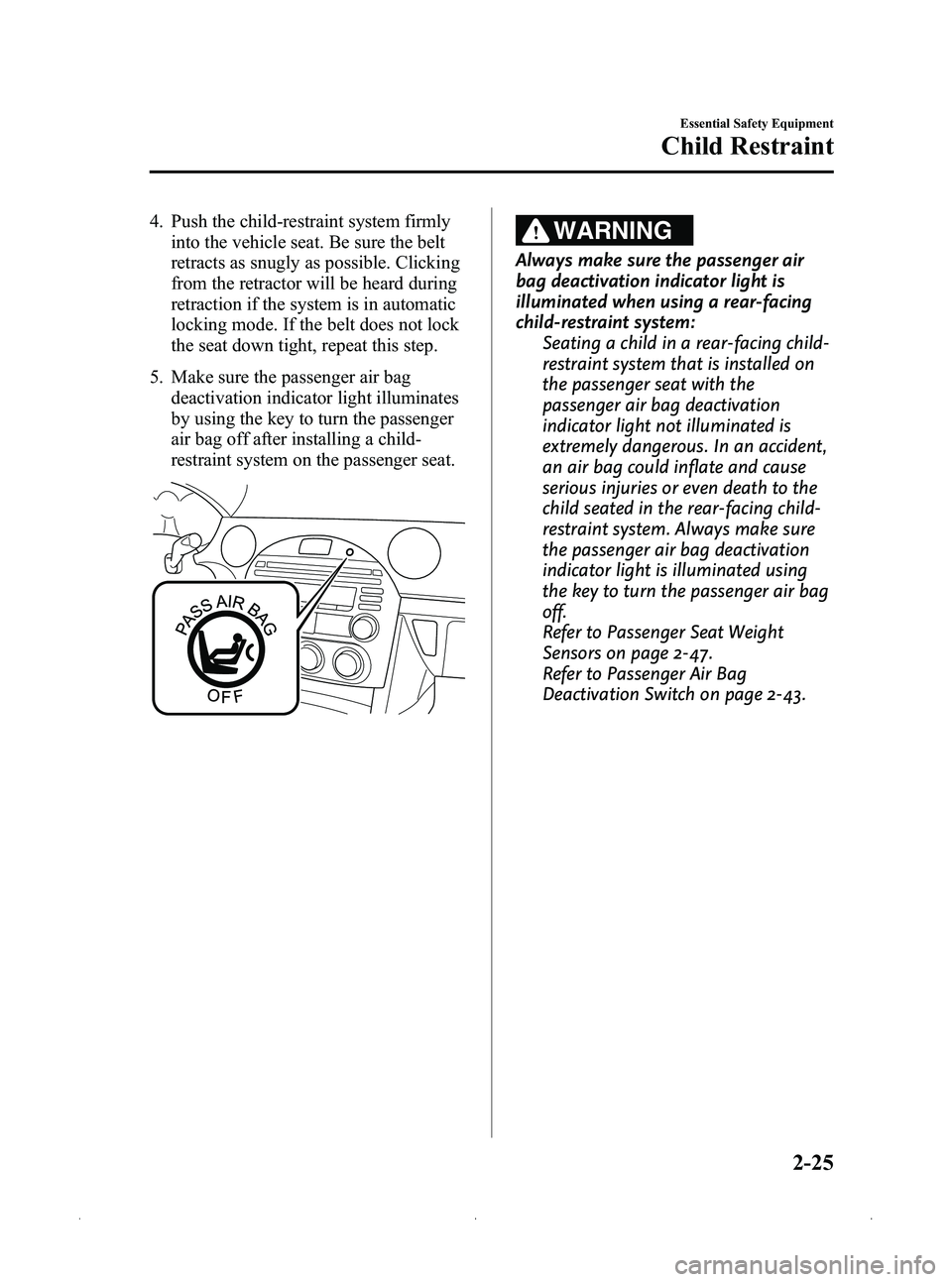
Black plate (37,1)
4. Push the child-restraint system firmlyinto the vehicle seat. Be sure the belt
retracts as snugly as possible. Clicking
from the retractor will be heard during
retraction if the system is in automatic
locking mode. If the belt does not lock
the seat down tight, repeat this step.
5. Make sure the passenger air bag deactivation indicator light illuminates
by using the key to turn the passenger
air bag off after installing a child-
restraint system on the passenger seat.WARNING
Always make sure the passenger air
bag deactivation indicator light is
illuminated when using a rear-facing
child-restraint system: Seating a child in a rear-facing child-
restraint system that is installed on
the passenger seat with the
passenger air bag deactivation
indicator light not illuminated is
extremely dangerous. In an accident,
an air bag could inflate and cause
serious injuries or even death to the
child seated in the rear-facing child-
restraint system. Always make sure
the passenger air bag deactivation
indicator light is illuminated using
the key to turn the passenger air bag
off.
Refer to Passenger Seat Weight
Sensors on page 2-47.
Refer to Passenger Air Bag
Deactivation Switch on page 2-43.
Essential Safety Equipment
Child Restraint
2-25
MX-5_8CC1-EA-11F_Edition2 Page37
Monday, July 18 2011 10:7 AM
Form No.8CC1-EA-11F
Page 38 of 456
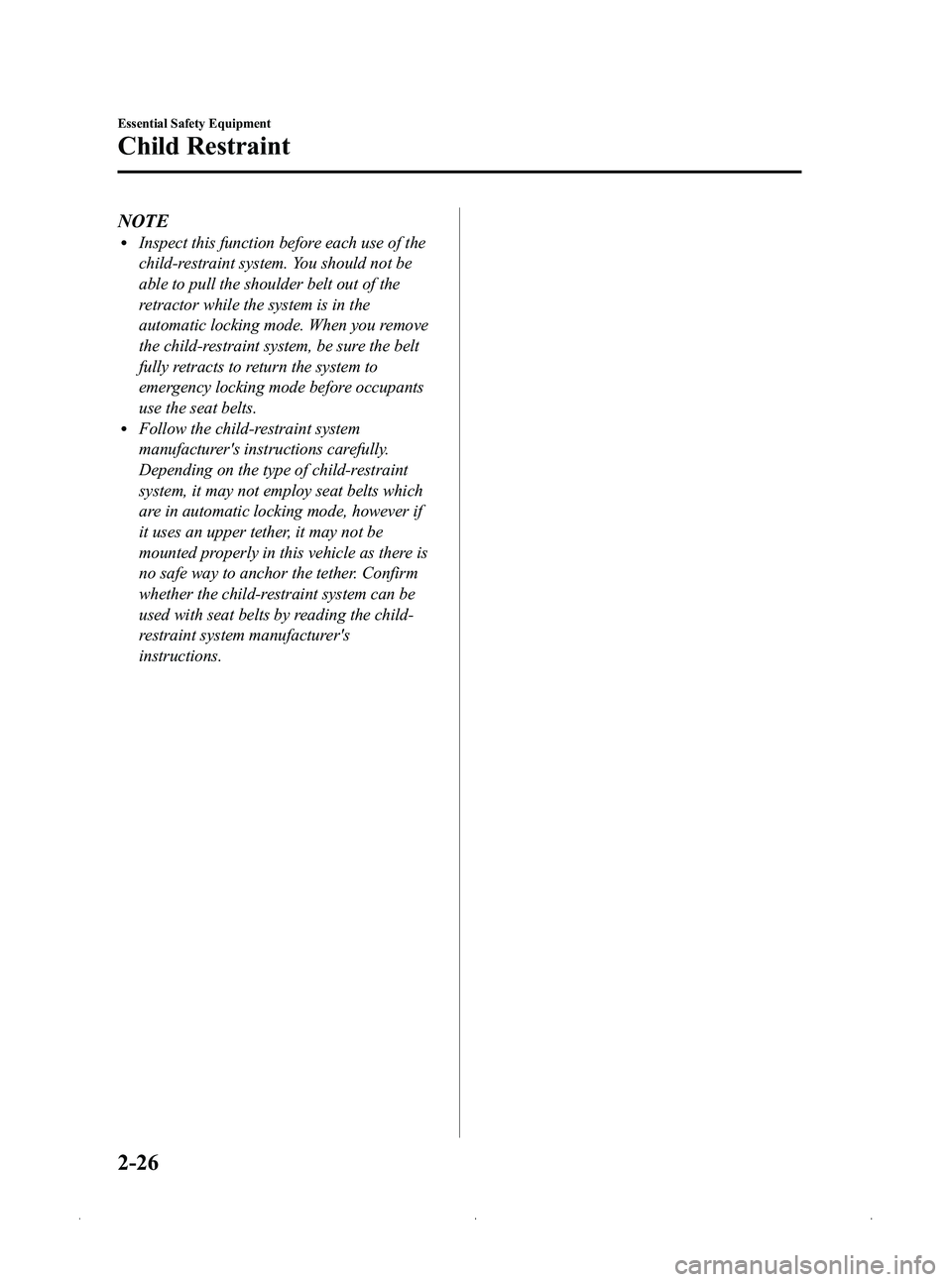
Black plate (38,1)
NOTElInspect this function before each use of the
child-restraint system. You should not be
able to pull the shoulder belt out of the
retractor while the system is in the
automatic locking mode. When you remove
the child-restraint system, be sure the belt
fully retracts to return the system to
emergency locking mode before occupants
use the seat belts.
lFollow the child-restraint system
manufacturer's instructions carefully.
Depending on the type of child-restraint
system, it may not employ seat belts which
are in automatic locking mode, however if
it uses an upper tether, it may not be
mounted properly in this vehicle as there is
no safe way to anchor the tether. Confirm
whether the child-restraint system can be
used with seat belts by reading the child-
restraint system manufacturer's
instructions.
2-26
Essential Safety Equipment
Child Restraint
MX-5_8CC1-EA-11F_Edition2 Page38
Monday, July 18 2011 10:7 AM
Form No.8CC1-EA-11F
Page 39 of 456
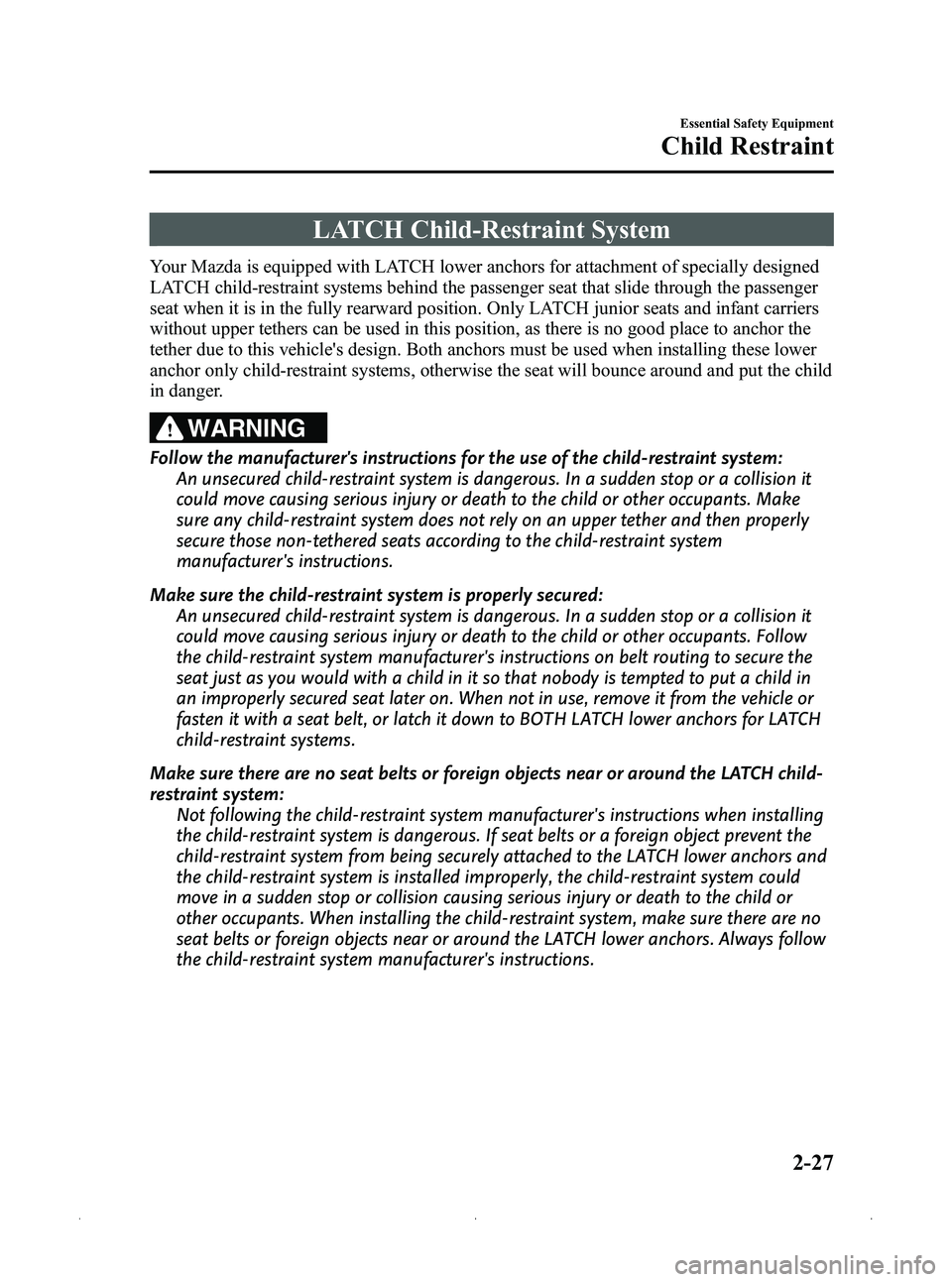
Black plate (39,1)
LATCH Child-Restraint System
Your Mazda is equipped with LATCH lower anchors for attachment of specially designed
LATCH child-restraint systems behind the passenger seat that slide through the passenger
seat when it is in the fully rearward position. Only LATCH junior seats and infant carriers
without upper tethers can be used in this position, as there is no good place to anchor the
tether due to this vehicle's design. Both anchors must be used when installing these lower
anchor only child-restraint systems, otherwise the seat will bounce around and put the child
in danger.
WARNING
Follow the manufacturer's instructions for the use of the child-restraint system:An unsecured child-restraint system is dangerous. In a sudden stop or a collision it
could move causing serious injury or death to the child or other occupants. Make
sure any child-restraint system does not rely on an upper tether and then properly
secure those non-tethered seats according to the child-restraint system
manufacturer's instructions.
Make sure the child-restraint system is properly secured: An unsecured child-restraint system is dangerous. In a sudden stop or a collision it
could move causing serious injury or death to the child or other occupants. Follow
the child-restraint system manufacturer's instructions on belt routing to secure the
seat just as you would with a child in it so that nobody is tempted to put a child in
an improperly secured seat later on. When not in use, remove it from the vehicle or
fasten it with a seat belt, or latch it down to BOTH LATCH lower anchors for LATCH
child-restraint systems.
Make sure there are no seat belts or foreign objects near or around the LATCH child-
restraint system: Not following the child-restraint system manufacturer's instructions when installing
the child-restraint system is dangerous. If seat belts or a foreign object prevent the
child-restraint system from being securely attached to the LATCH lower anchors and
the child-restraint system is installed improperly, the child-restraint system could
move in a sudden stop or collision causing serious injury or death to the child or
other occupants. When installing the child-restraint system, make sure there are no
seat belts or foreign objects near or around the LATCH lower anchors. Always follow
the child-restraint system manufacturer's instructions.
Essential Safety Equipment
Child Restraint
2-27
MX-5_8CC1-EA-11F_Edition2 Page39
Monday, July 18 2011 10:7 AM
Form No.8CC1-EA-11F
Page 40 of 456
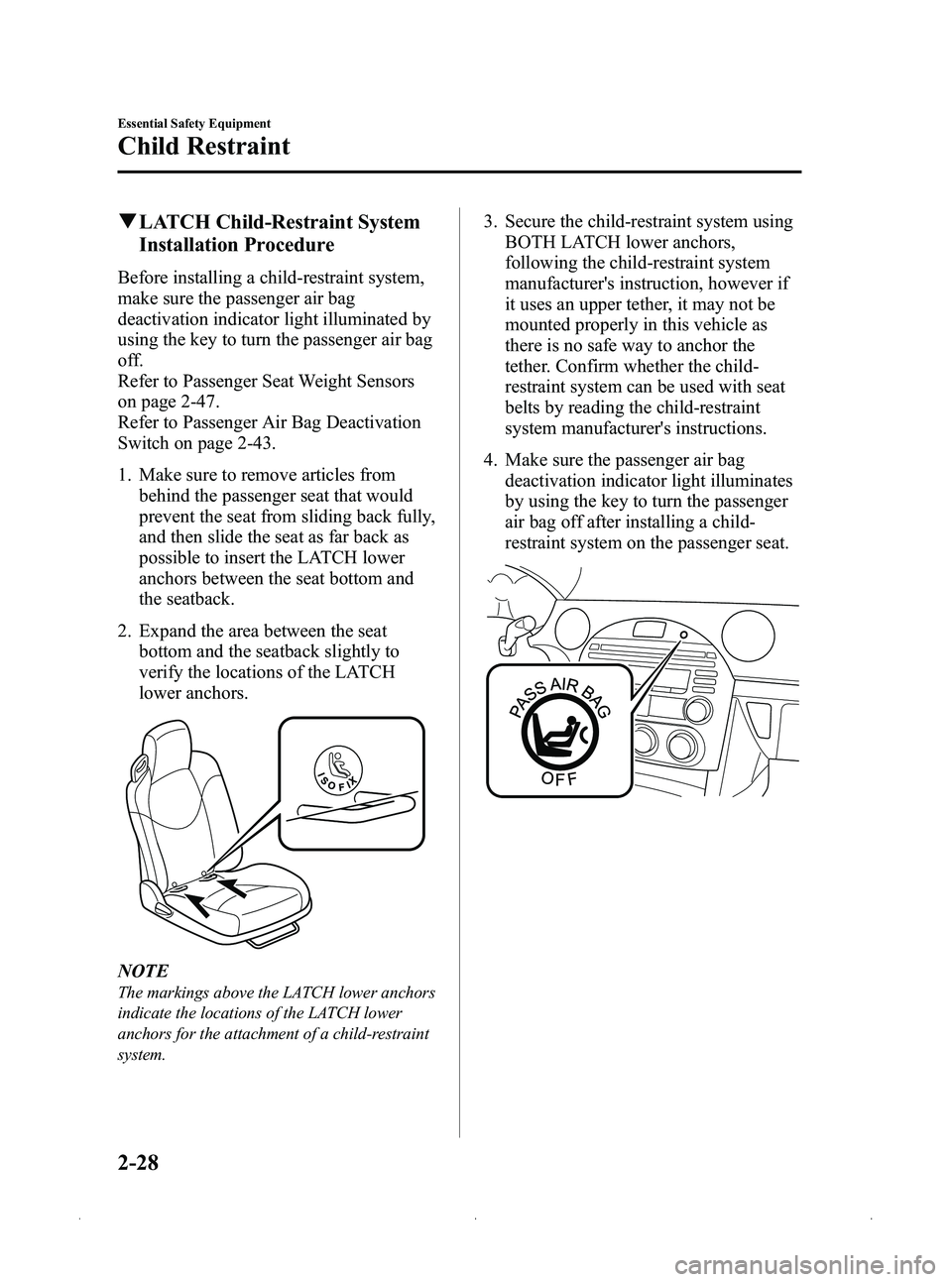
Black plate (40,1)
qLATCH Child-Restraint System
Installation Procedure
Before installing a child-restraint system,
make sure the passenger air bag
deactivation indicator light illuminated by
using the key to turn the passenger air bag
off.
Refer to Passenger Seat Weight Sensors
on page 2-47.
Refer to Passenger Air Bag Deactivation
Switch on page 2-43.
1. Make sure to remove articles from
behind the passenger seat that would
prevent the seat from sliding back fully,
and then slide the seat as far back as
possible to insert the LATCH lower
anchors between the seat bottom and
the seatback.
2. Expand the area between the seat bottom and the seatback slightly to
verify the locations of the LATCH
lower anchors.
NOTE
The markings above the LATCH lower anchors
indicate the locations of the LATCH lower
anchors for the attachment of a child-restraint
system.
3. Secure the child-restraint system usingBOTH LATCH lower anchors,
following the child-restraint system
manufacturer's instruction, however if
it uses an upper tether, it may not be
mounted properly in this vehicle as
there is no safe way to anchor the
tether. Confirm whether the child-
restraint system can be used with seat
belts by reading the child-restraint
system manufacturer's instructions.
4. Make sure the passenger air bag deactivation indicator light illuminates
by using the key to turn the passenger
air bag off after installing a child-
restraint system on the passenger seat.
2-28
Essential Safety Equipment
Child Restraint
MX-5_8CC1-EA-11F_Edition2 Page40
Monday, July 18 2011 10:7 AM
Form No.8CC1-EA-11F
Page 42 of 456
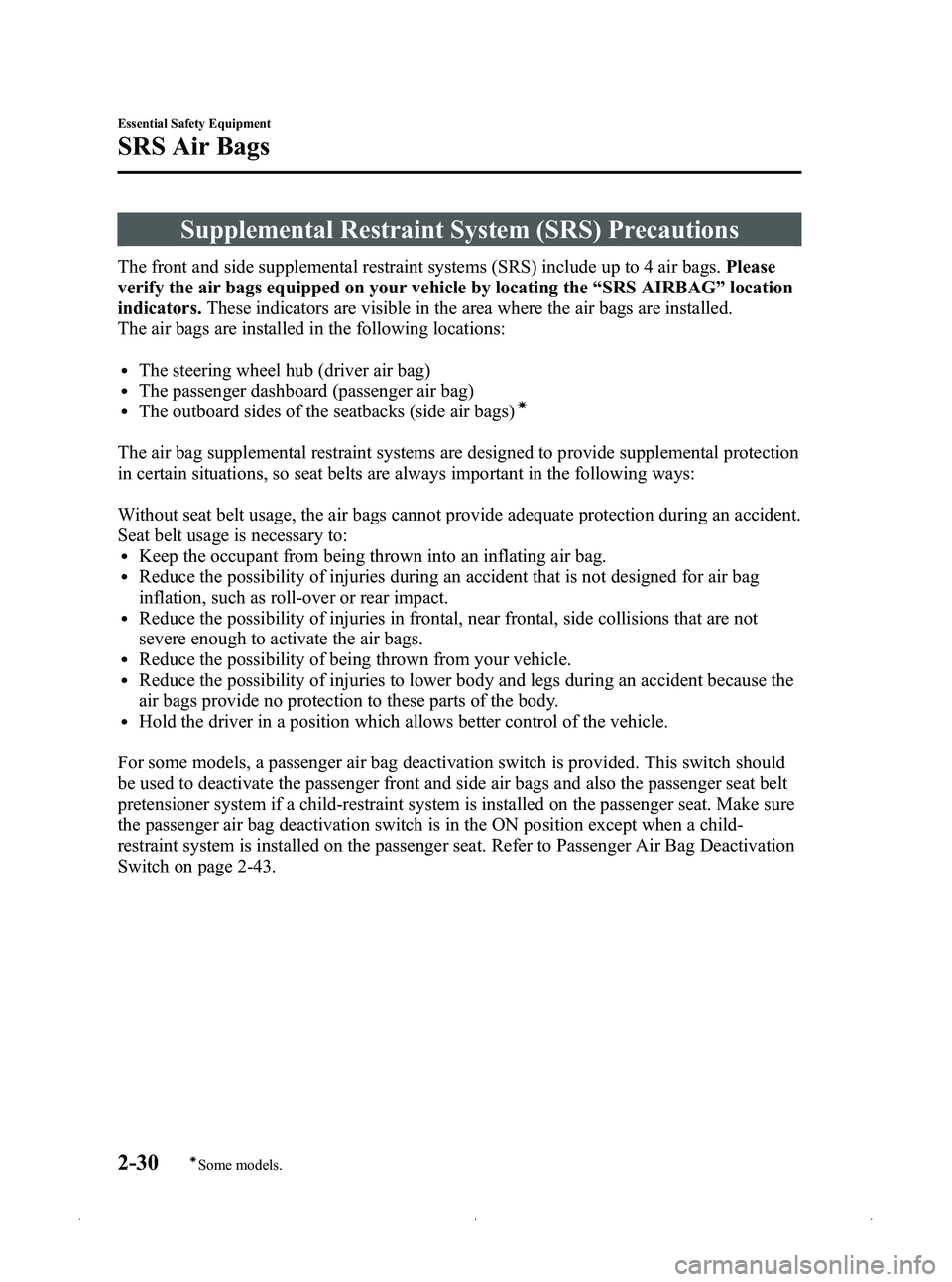
Black plate (42,1)
Supplemental Restraint System (SRS) Precautions
The front and side supplemental restraint systems (SRS) include up to 4 air bags.Please
verify the air bags equipped on your vehicle by locating the “SRS AIRBAG ”location
indicators. These indicators are visible in the area where the air bags are installed.
The air bags are installed in the following locations:
lThe steering wheel hub (driver air bag)lThe passenger dashboard (passenger air bag)lThe outboard sides of the seatbacks (side air bags)í
The air bag supplemental restraint systems are designed to provide supplemental protection
in certain situations, so seat belts are always important in the following ways:
Without seat belt usage, the air bags cannot provide adequate protection during an accident.
Seat belt usage is necessary to:
lKeep the occupant from being thrown into an inflating air bag.lReduce the possibility of injuries during an accident that is not designed for air bag
inflation, such as roll-over or rear impact.
lReduce the possibility of injuries in frontal, near frontal, side collisions that are not
severe enough to activate the air bags.
lReduce the possibility of being thrown from your vehicle.lReduce the possibility of injuries to lower body and legs during an accident because the
air bags provide no protection to these parts of the body.
lHold the driver in a position which allows better control of the vehicle.
For some models, a passenger air bag deactivation switch is provided. This switch should
be used to deactivate the passenger front and side air bags and also the passenger seat belt
pretensioner system if a child-restraint system is installed on the passenger seat. Make sure
the passenger air bag deactivation switch is in the ON position except when a child-
restraint system is installed on the passenger seat. Refer to Passenger Air Bag Deactivation
Switch on page 2-43.
2-30
Essential Safety Equipment
íSome models.
SRS Air Bags
MX-5_8CC1-EA-11F_Edition2 Page42
Monday, July 18 2011 10:7 AM
Form No.8CC1-EA-11F
Page 43 of 456
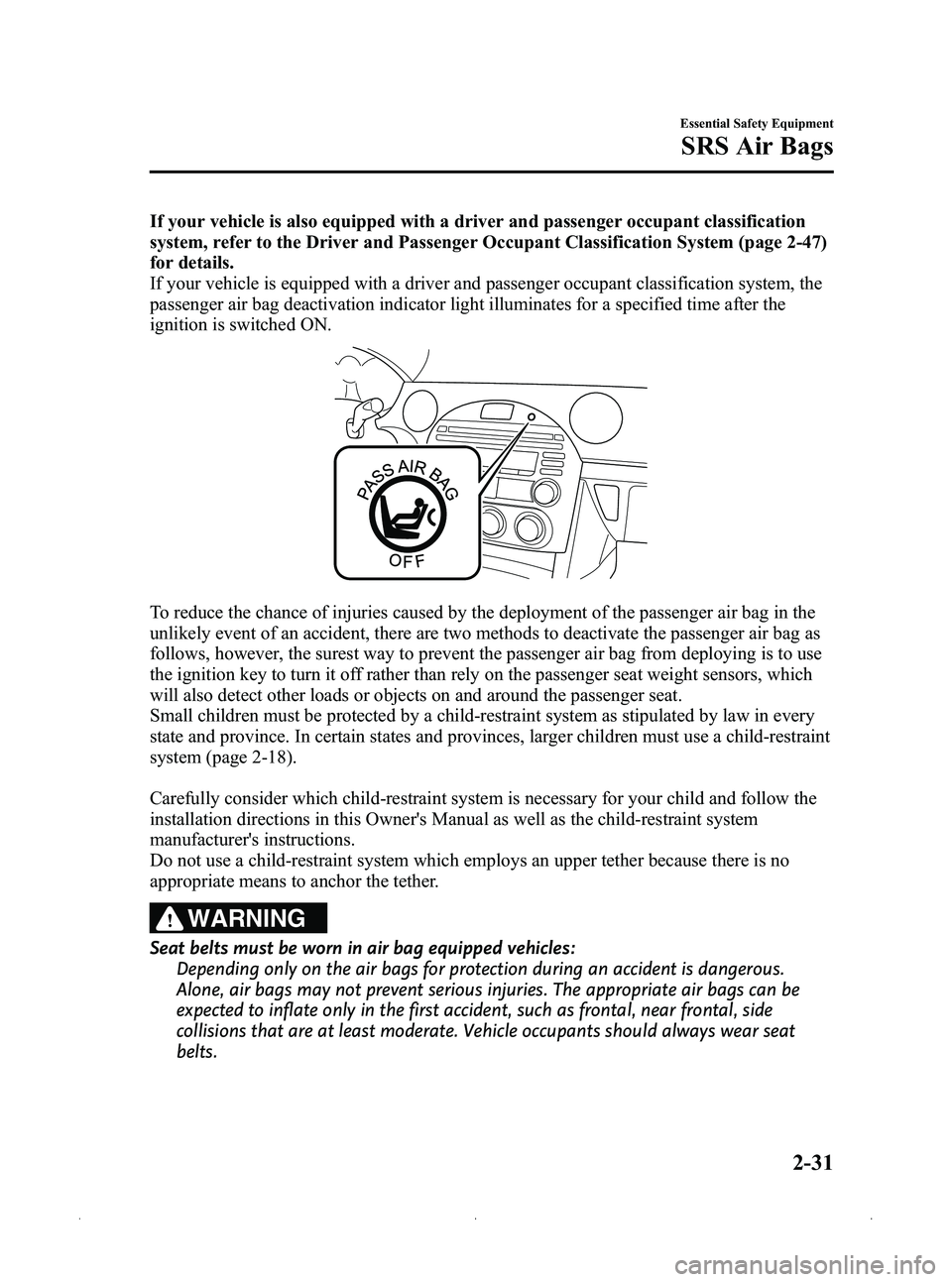
Black plate (43,1)
If your vehicle is also equipped with a driver and passenger occupant classification
system, refer to the Driver and Passenger Occupant Classification System (page 2-47)
for details.
If your vehicle is equipped with a driver and passenger occupant classification system, the
passenger air bag deactivation indicator light illuminates for a specified time after the
ignition is switched ON.
To reduce the chance of injuries caused by the deployment of the passenger air bag in the
unlikely event of an accident, there are two methods to deactivate the passenger air bag as
follows, however, the surest way to prevent the passenger air bag from deploying is to use
the ignition key to turn it off rather than rely on the passenger seat weight sensors, which
will also detect other loads or objects on and around the passenger seat.
Small children must be protected by a child-restraint system as stipulated by law in every
state and province. In certain states and provinces, larger children must use a child-restraint
system (page 2-18).
Carefully consider which child-restraint system is necessary for your child and follow the
installation directions in this Owner's Manual as well as the child-restraint system
manufacturer's instructions.
Do not use a child-restraint system which employs an upper tether because there is no
appropriate means to anchor the tether.
WARNING
Seat belts must be worn in air bag equipped vehicles:Depending only on the air bags for protection during an accident is dangerous.
Alone, air bags may not prevent serious injuries. The appropriate air bags can be
expected to inflate only in the first accident, such as frontal, near frontal, side
collisions that are at least moderate. Vehicle occupants should always wear seat
belts.
Essential Safety Equipment
SRS Air Bags
2-31
MX-5_8CC1-EA-11F_Edition2 Page43
Monday, July 18 2011 10:7 AM
Form No.8CC1-EA-11F
Page 44 of 456
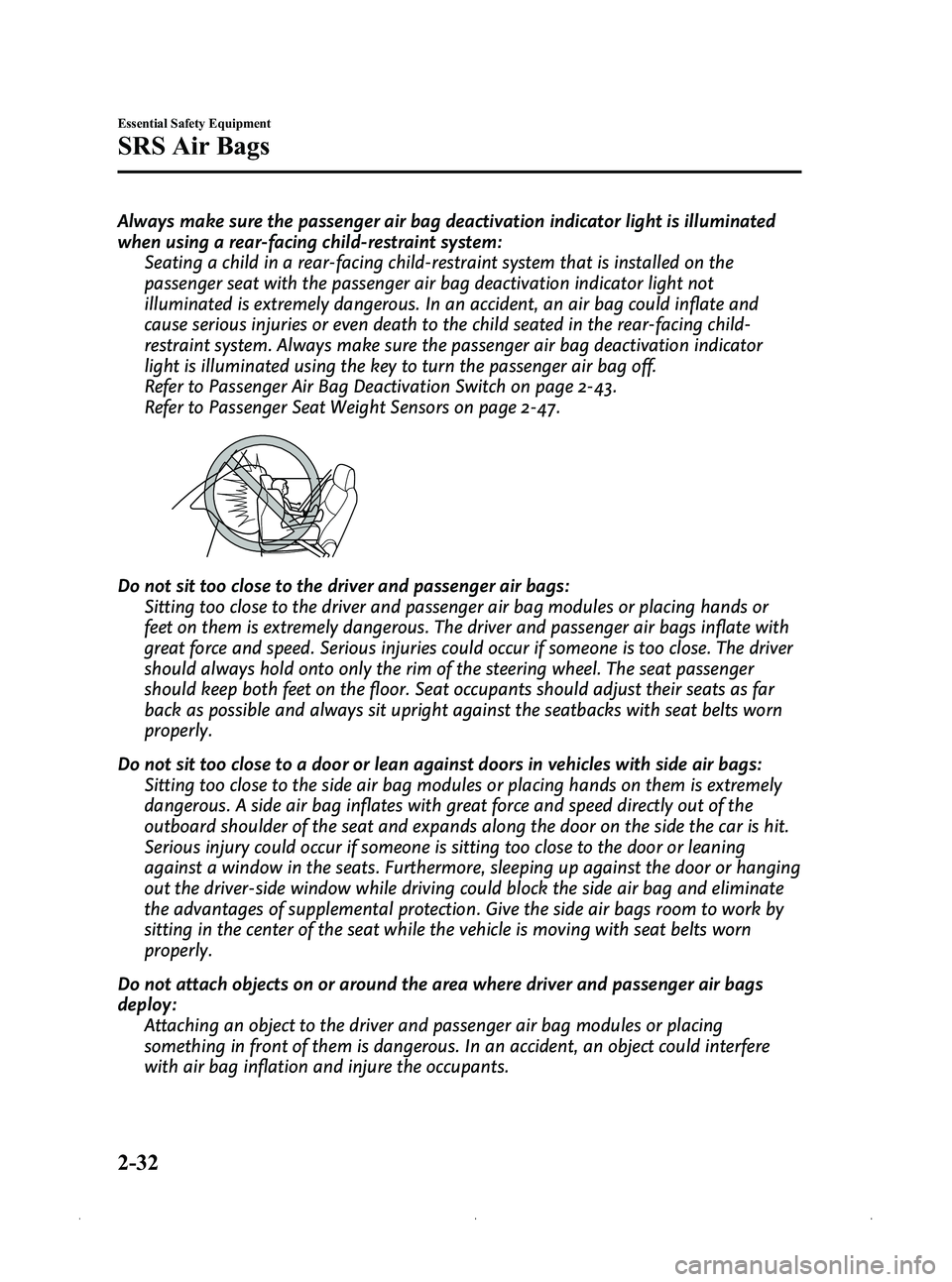
Black plate (44,1)
Always make sure the passenger air bag deactivation indicator light is illuminated
when using a rear-facing child-restraint system:Seating a child in a rear-facing child-restraint system that is installed on the
passenger seat with the passenger air bag deactivation indicator light not
illuminated is extremely dangerous. In an accident, an air bag could inflate and
cause serious injuries or even death to the child seated in the rear-facing child-
restraint system. Always make sure the passenger air bag deactivation indicator
light is illuminated using the key to turn the passenger air bag off.
Refer to Passenger Air Bag Deactivation Switch on page 2-43.
Refer to Passenger Seat Weight Sensors on page 2-47.
Do not sit too close to the driver and passenger air bags:
Sitting too close to the driver and passenger air bag modules or placing hands or
feet on them is extremely dangerous. The driver and passenger air bags inflate with
great force and speed. Serious injuries could occur if someone is too close. The driver
should always hold onto only the rim of the steering wheel. The seat passenger
should keep both feet on the floor. Seat occupants should adjust their seats as far
back as possible and always sit upright against the seatbacks with seat belts worn
properly.
Do not sit too close to a door or lean against doors in vehicles with side air bags: Sitting too close to the side air bag modules or placing hands on them is extremely
dangerous. A side air bag inflates with great force and speed directly out of the
outboard shoulder of the seat and expands along the door on the side the car is hit.
Serious injury could occur if someone is sitting too close to the door or leaning
against a window in the seats. Furthermore, sleeping up against the door or hanging
out the driver-side window while driving could block the side air bag and eliminate
the advantages of supplemental protection. Give the side air bags room to work by
sitting in the center of the seat while the vehicle is moving with seat belts worn
properly.
Do not attach objects on or around the area where driver and passenger air bags
deploy: Attaching an object to the driver and passenger air bag modules or placing
something in front of them is dangerous. In an accident, an object could interfere
with air bag inflation and injure the occupants.
2-32
Essential Safety Equipment
SRS Air Bags
MX-5_8CC1-EA-11F_Edition2 Page44
Monday, July 18 2011 10:7 AM
Form No.8CC1-EA-11F